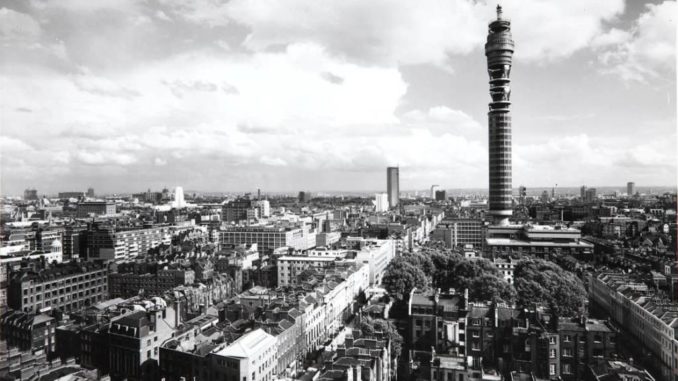
Tower running is celebrating its 50th anniversary in the UK this year, with the first recorded stair race having taken place in April 1968 at London’s GPO Tower (now BT Tower).
Students from the University of London competed against the University of Edinburgh in a time trial format race up the 798 steps. Edinburgh came out on top.
The tower had been commissioned by the General Post Office to support microwave aerials carrying telecommunications transmissions from London to the rest of the country. Work began in June 1961 and was finished in July 1964, at a cost of £2.5 million.
Upon completion the tower became the tallest building in the UK – a title it would hold until the completion of the Natwest Tower (Tower 42) in 1980. It wasn’t until October 1965 that it would officially open, in a ceremony with then Prime Minister Harold Wilson in attendance.
On Thursday 18th April 1968, students from University College London organised a run to the top of the tower, as part of the RAG Committees activities that year. They invited students from the University of Edinburgh to compete against them.
By the time the event finished, the Londoners may well have regretted their choice of competition. Edinburgh sent down a team made up of members of the athletics and cross-country teams. They were among the best athletes in the country at the time.
Earlier in 1968, the University of Edinburgh Hare and Hounds cross-country team had won the British Universities Cross Country title. They had also won the team title at the Scottish National Cross Country Championship, becoming the first and only university team to have done so.
The Edinburgh team that attended the event was made up of: Hugh Stevenson (high hurdles), Jack MacFie (800m and cross-country), Iain Hathorn (400/800m and cross country), Andy McKean, John Exley and Ken Fyfe (all cross country). Also in attendance was Sheila Duncan, the only woman racing on the day.
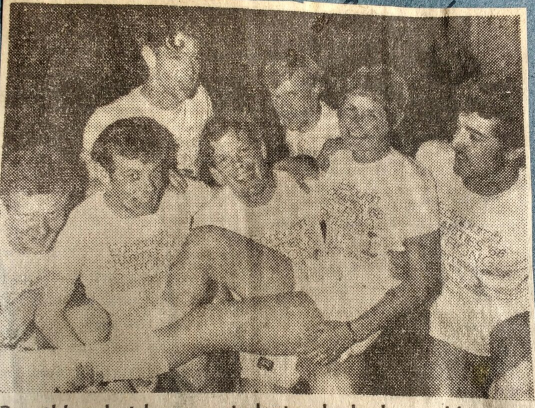
The seven-person Edinburgh team completely dominated the event. The men filled the top six places on the leaderboard, with cross-country athlete and 800m track specialist Jack MacFie taking the overall win, and establishing the course record, in a time of 4.46.
The previous record, set in 1967 by an unknown University of London student, stood at 6.02.
Behind him were Andy McKean (4.59), Ken Fyfe and Iain Hathorn (5.10), John Exley (5.32) and Hugh Stevenson (5.35).
Sheila Duncan finished in a time of 7.06. She was a multi-eventer on the university’s athletics team, but was better known as a hockey player who went on to represent the Scottish national team.
Tower Running UK got in touch with Andy McKean, a first year architecture student at the time, and team mates John Exley and Hugh Stevenson, to find out what memories remained of that race 50 years ago. Following the event, Andy went on to win four Scottish Cross Country titles, represented Scotland at international races, and competed in the inaugural World Cross Country Championship in 1973.
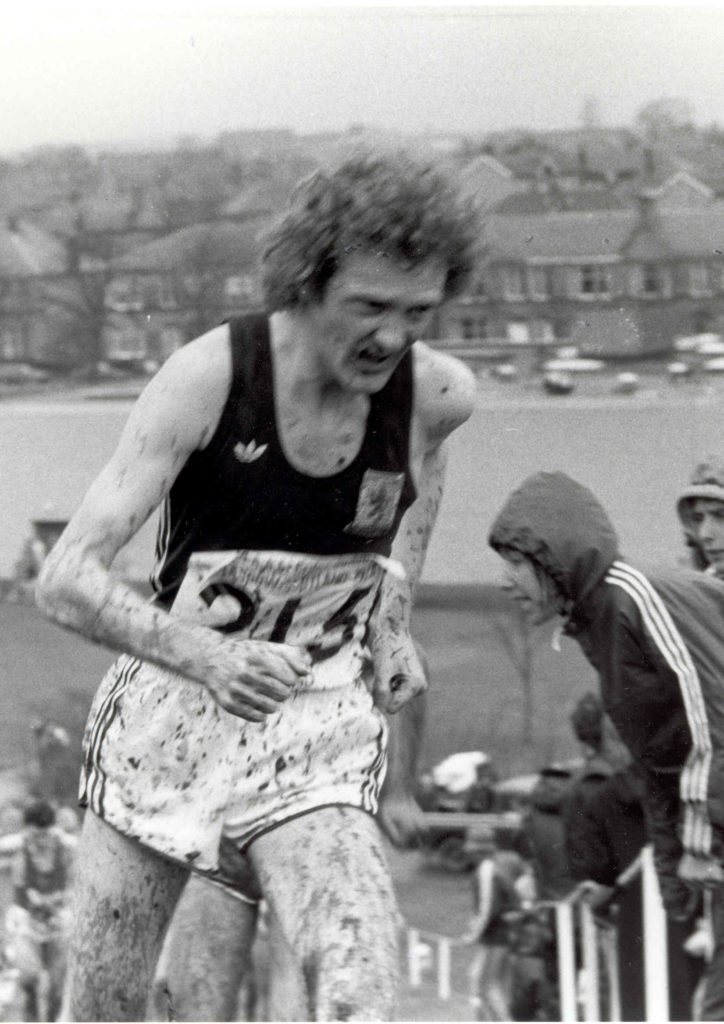
“I think our participation may have been in some way associated with the Edinburgh Charities Week – i.e as a kind of charity stunt. I recall receiving a t-shirt emblazoned with the GPO Tower and a charity name, although I cannot remember which one. It must have been organised rather at the last minute and on a shoe string: we all traveled down by car the night before (fortunately with other friends driving), and back to Edinburgh again overnight the night after; so I was absolutely knackered when we got home!”
Remarkably, Hugh Stevenson still had his 50-year old t-shirt when Tower Running UK heard from him. He said the team had been sponsored by the Scottish Milk Marketing Board in aid of Edinburgh Student Charities, and the t-shirts had ‘Edinburgh Charities Strong Pintamen up GPO Tower’ written on them.
The BT Tower has a very narrow stairwell, a problem that hindered McKean on the day:
“In truth I was a bit too tall for it, as the space was fairly confined and actually felt quite claustrophobic at times.”
But he recalls the victorious Jack MacFie was well suited to it:
“Yes, Jack was indeed the fastest on the day, and I remember us all reflecting afterwards that he had exactly the right build for the event, slightly stocky (by distance running standards) but sufficiently strong and agile for managing the steps and turns at the stair landings.”
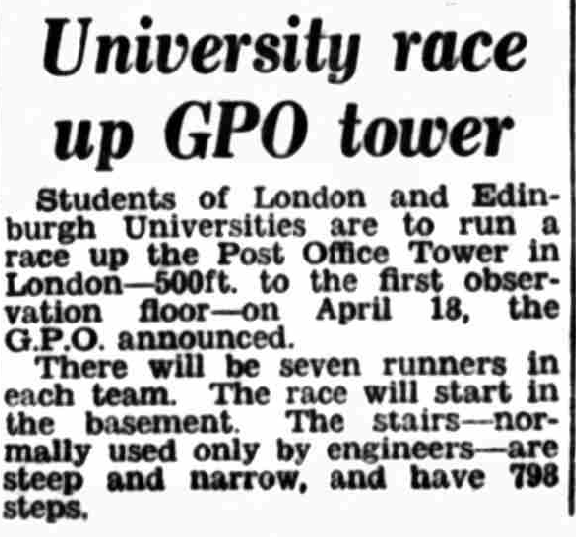
An event to rival the Oxbridge Boat Race
Hugh Stevenson recalled well-known TV presenter Alex Mackintosh interviewing race winner Jack MacFie.
“‘Well Jack, now that you’ve got your breath back, how does it feel to be World All Comers Record Holder for the Post Office Tower?’. To which the reply was, ‘All right I suppose.’ The nightmare continued with, ‘How are the team going to celebrate your victory tonight?’ Jack replied, ‘Have a few drinks I suppose, then drive back up to Edinburgh’ Cue panic cries from producer, ‘Cut! Cut! Can’t have that!’.”
The event caught the imagination of the press, with one journalist commenting that “In years to come the Tower Race could take the place of the old-styled boat race between Oxford and Cambridge.
50 years on and nothing close to that has materialised, and the sport in the UK is still very much in its infancy in terms of numbers of participants, media coverage, recognition and respect.
After an IRA bomb, the event never returned.
The event organisers managed to run the event again in 1969, expanding the event to include students from eight universities, but without the participation of the University of Edinburgh.
John Pearson of Manchester University was fastest in 1969, reaching the top in 5.07.
1970 would be the last year this University of London-organised event took place. Scottish athlete Norman Morrison, at the time a mathematics student at Imperial College, won the event and set a new course record of 4.21.
The only woman at the event that year was Hilary Tanner, representing Hull University. Like the fastest man at the race, she also set a new course record, with her time of 7.00.
An IRA bomb at the BT Tower in 1971 led to its closure to the public, and the event never returned.
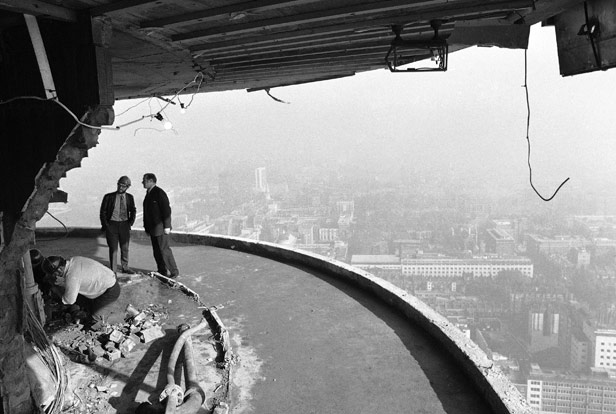
Additional content by Tower Running UK.
